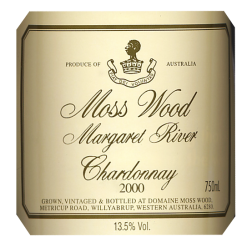Moss Wood 2000 Chardonnay
| Harvested: | 29/2/2000 |
| Bottled: | 10/2/2001 |
| Released: | 15/4/2001 |
| Yield: | 5.20 t/ha |
| Baume: | 13.40 |
| Alcohol: | 13.50% |
| Vintage Rating: | 8/10 |
SOLD OUT
Moss Wood 2000 Chardonnay – James Halliday – The Wine Companion
Light to medium yellow-green; the oak is immediately obvious on the bouquet, and yet to settle down and integrate; however, the palate leaves no doubt this will happen, for it has lovely texture, weight and feel. Melon, a touch of citrus and a hint of fig show through strongly, the…
Tasting Notes
The 2000 Moss Wood Chardonnay is a fresh, lively wine. On the nose it shows primary fruit aromas of peach, melon, pineapple, passionfruit and grapefruit. It also displays the traditional complexity of chardonnay, although the fruit richness has tended to push this into the background slightly more than usual. However, there is integrated, smoky oak as well as doughy yeast autolysis characters and hints of caramel overtones from the malolactic fermentation. One observation of the Moss Wood team is that this is a wine which needs some breathing time. Soon after opening the nose can be dominated somewhat by the wild yeast fermentation characters, but these soften after about 15-30 minutes. These characters follow through on the palate. The fruit flavours give a sweet, mouth-filling texture, which is smooth, rich and long, all underpinned by crisp acidity and some oak and tannin notes on the finish.
In terms of wine style and quality, we believe that 2000 is very similar to 1980. If pressed, under the threat of torture, to choose between them we would probably go for the former because it had less bird damage and the timing of the rain was also better. Apart from that, they are nearly twins with wines from both years showing lively and generous fruit characters with the sort of balance that makes them really very enjoyable - 'yummy' in fact!
Vintage Notes
In February 2000, Moss Wood vineyard manager, Matt Bowden, was a happy man. The growing season for the 2000 vintage had been a beauty - not even the birds were a problem. There were some hot days during December but January and February were mild. A small amount of rain in late January came soon enough to refresh the vines but on the other hand, not late enough to cause any damage to the fruit. The chardonnay crop was in very good order indeed.
Picking started on 1st March and ran for three days. All came in according to plan although, at 14° Beaume, the two main blocks were riper than the expected 13.5°. Technically speaking, it should have started two or three days earlier but then nobody is perfect!
Production Notes
As usual, the processing was divided into two parts. The 'clonal chardonnay' was picked separately and whole bunch pressed: the juice was then put straight into barrel for fermentation, allowing for inoculation by wild yeast culture. This slightly aggressive technique is used because these clones, selected from the University of California at Davis, are very high yielding and tend to lack good fruit flavour. In fact, around Margaret River they are disparagingly referred to as the 'Trebbiano clones' because of their uncanny resemblance to this high yielding, neutral grape variety. To gain more complexity, the Moss Wood crew retain more solids than usual in the juice and carry out the entire fermentation in wood.
The main batch, made using the Mendoza clone, is much more flavoursome and is treated more carefully to retain and enhance its good fruit depth. In this instance, the bunches were de-stemmed, the grapes pumped through the must chiller (which is cooled to 8° Celsius) and then added to the press. Two lots of juice result: the free-run (the juice which drains off before pressing takes place) and the pressings (that which is extracted by the pressing process). These are combined, settled for 48 hours at 12° Celsius and then pumped to a fermentation tank.
At this point, the juice is allowed to warm up and fermentation commences. For the 2000 Chardonnay, wild yeasts were allowed to start the process, and a pure yeast strain was added during fermentation to finish it off. Debate continues about the benefits this sequential inoculation technique brings. While there is no doubt in our mind that the indigenous yeasts do add complexity to the wine, the risk associated with using a culture whose characteristics are not known in advance, is a worry. The loss of control over the process that this brings adds a commercial risk that is hard to justify, given the relatively small quality gains.
Once fermentation was underway, batonnage (lees stirring) was done once per day, both in tank and barrel. In the stainless steel tank the wine was held at 18° Celsius and, when moved to casks where it was kept at ambient temperature. From the 2001 vintage, there will be even greater control because all the barrel cellars are now air-conditioned. After the primary ferment finished, the lees stirring continued once a week until the malolactic fermentation was completed. Then the wine was left undisturbed on its lees in new 225 litre French oak barriques for a total of ten months. It was bottled at the beginning of February 2001.
Cellaring Notes
With these flavours and structure together with delicacy and finesse, the wine has significant appeal for early drinking. It is quite luscious in fact. However, that same structure, powerful flavours and good natural acidity will also provide a basis for long-term ageing and the wine can be cellared with confidence for between 10 to 15 years. Optimum drinking 2007.

